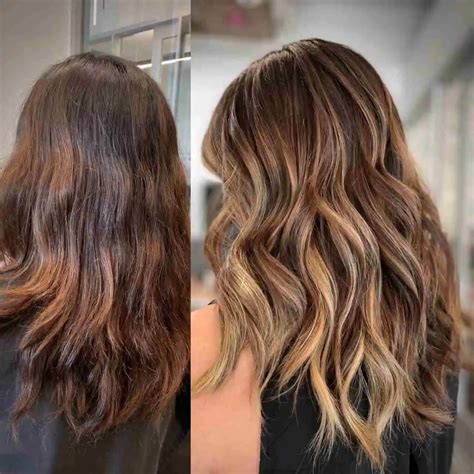Introduction
Balayage, a French hair coloring technique, has surged in popularity, captivating hearts with its ability to create natural-looking, sun-kissed highlights. However, amidst the frenzy over this technique arises a burning question: partial balayage vs full balayage? Delve into this comprehensive guide to unravel the intricacies of each method, empowering you with the knowledge to make an informed decision.

Partial Balayage
Pain Points:
- Limited impact: Partial balayage focuses solely on specific sections of the hair, leading to a less comprehensive coloration compared to full balayage.
- Suitable for: Individuals seeking subtle highlights or a touch-up to existing balayage.
Motivations:
- Less time-consuming: With a smaller area to cover, partial balayage typically takes less time to complete.
- Budget-friendly: Reduced coverage translates to lower costs.
Full Balayage
Pain Points:
- Time commitment: Full balayage entails coloring the entire head of hair, making it a more time-intensive procedure.
- Higher price point: The larger surface area involved increases the cost of full balayage compared to its partial counterpart.
Motivations:
- Comprehensive transformation: Full balayage provides a complete overhaul, delivering a dramatic change in hair color and dimension.
- Suitable for: Individuals desiring a significant shift in their hair color or those with naturally dark hair.
Comparison Table
| Feature | Partial Balayage | Full Balayage |
|---|---|---|
| Coverage | Specific sections | Entire head |
| Time | Less time-consuming | Time-intensive |
| Cost | Budget-friendly | Higher price point |
| Impact | Subtle highlights | Comprehensive transformation |
| Suitability | Touch-ups, subtle changes | Dramatic shifts, dark hair |
Benefits of Balayage
Partial Balayage:
- Low commitment: Allows for gradual hair color changes without altering the entire head.
- Customizable: Can be tailored to suit individual preferences, from subtle streaks to more pronounced highlights.
Full Balayage:
- Dramatic transformation: Creates a completely new look, adding depth and dimension to the hair.
- Low-maintenance: Blends seamlessly with natural hair color, minimizing the need for frequent touch-ups.
Common Mistakes to Avoid
- Over-bleaching: Excessive bleaching can compromise hair health, leading to breakage and dryness.
- Incorrect placement: Misplaced highlights can create an unnatural appearance.
- Ignoring hair texture: Balayage should be customized based on hair type and texture to achieve optimal results.
Why Partial or Full Balayage Matters
- Confidence boost: Balayage can enhance self-esteem by providing a transformative hair makeover.
- Personal expression: Allows individuals to express their creativity and individuality through their hair color.
- Versatility: Balayage complements various hair lengths, colors, and styles.
Conclusion
The choice between partial balayage and full balayage depends on individual preferences and hair goals. Partial balayage offers a less drastic, budget-friendly option for subtle highlights or touch-ups. Full balayage, on the other hand, delivers a complete transformation, adding depth and dimension to the hair. By understanding the distinctions between these techniques, you can make an informed decision that empowers you to achieve your desired hair color.
Frequently Asked Questions (FAQs)
Q: How often should I get a balayage touch-up?
A: Depending on the extent of coverage and hair growth rate, touch-ups are typically recommended every 4-6 months.
Q: Is balayage suitable for all hair types?
A: Yes, balayage can be customized to complement all hair textures and types, from fine to coarse.
Q: How do I care for my balayage-treated hair?
A: Use sulfate-free shampoos and conditioners, protect against heat styling, and avoid excessive washing to preserve the vibrancy and longevity of your highlights.
Q: Can I DIY balayage?
A: It is strongly recommended to consult a professional hair stylist for balayage as it requires technical expertise to achieve optimal results.
